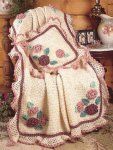For beginners at sewing, or folks who haven't sewn for years,
www.nancysnotions.com has some really excellent reference and educational materials. She has several books out, including some on quilting, on "remodeling" clothing (making it more "in style", or fits better). Some include DVD's, for those who learn easier in that format.
In my experience, there are a few tools for sewing that you REALLY don't want to be without. GOOD scissors (I LOVE either the Mundial or Gingher brands of scissors... they aren't cheap, but with reasonable care, they'll last a lifetime). If you can't afford those, consider Fiskars... and a sharpener.
GOOD pins... that means glass (or other melt-proof) heads, very sharp, and as fine as will work for your project. If you are going to be working with leather, vinyl, or other materials where "holes" will show after a pin is removed, consider buying a package of the clips they sell now... I used them when making fabric diapers, so the PUL waterproof outer layer wouldn't leak. I still personally prefer pins, but there are places for the clips:
http://www.nancysnotions.com/product/10+pack+assorted+regular+wonder+clips.do
If you have any plans for quilting, etc, you'll want a cutting mat and a rotary cutter. Extra blades, plus a way to sharpen them.
Good hand sewing needles, and plenty of extra sewing machine needles...more problems with stitches not being even, skipped stitches, etc are caused by worn, dull or damaged (bent) needles. You can extend the life of pins and needles by buying a "sharpening pad", and using it. IIRC, they used to sell pincushions filled with pumice rock... every time you put your pins or needles into it and remove them, it polished then and helped keep them sharp.
Something to make/trace patterns on... either heavy "tracing paper" (they sell it in rolls up to 48" wide), or (my preference) lightweight interfacing. I occasionally buy a bolt of lightweight *fusible* interfacing. It works fine for tracing off multi-size patterns, but it is really great for ironing onto tissue paper pattern pieces to reinforce them. I used to buy basic patterns when JoAnns would have them on sale for a buck... I'd buy as many as 6 of the same pattern, so I could cut out each size and iron on interfacing, to make a "lifetime" pattern. I have these for most of the basics- men's boxers, t-shirts, pull on sweat pants, nightwear, swearshirts, turtlenecks, etc...
Awhile back, we were discussing thread. I've discovered that polyester thread tends to last much better than cotton in storage. If you're storing cotton thread, you need to be extra careful to keep it from being exposed to direct sunlight or excessive heat. (then again, a few spools of polyester I had which are probably 10 years old are fine- but the plastic cones they are wound on are disintegrating into dust!!)
I've since learned that you want to use polyester for any application where you want some stretch in the thread. Basically, use cotton for woven fabrics, and poly on all knits. For some really nice quality thread (as well as some super- and very nicely priced- thread storage containers), check out
www.connectingthreads.com
Get on their mailing list, and you'll find out when they're having 40% off all their thread- that's the time to stock up!
Summerthyme

 We had to learn how to plan, shop, prepare and cook meals and properly clean a house, do our own laundry....properly, learn to sew to do repair clothing, can food, bake, etc., etc., she even taught us to knit as part of our training, I recall that all I did was a simple square, but I have the idea of how to do it. Her idea was that we should be able to do all these "domestic" chores ourselves and not get married to have them done for us. Which is pretty smart when you really think about it. And it allowed us to both teach our wives those skills that their mothers hadn't bothered to pass down to them.....so much for women's liberation. Sad.
We had to learn how to plan, shop, prepare and cook meals and properly clean a house, do our own laundry....properly, learn to sew to do repair clothing, can food, bake, etc., etc., she even taught us to knit as part of our training, I recall that all I did was a simple square, but I have the idea of how to do it. Her idea was that we should be able to do all these "domestic" chores ourselves and not get married to have them done for us. Which is pretty smart when you really think about it. And it allowed us to both teach our wives those skills that their mothers hadn't bothered to pass down to them.....so much for women's liberation. Sad. 
 Well, a word to the wise: don't put the squirt-on flee and tick treatment on three dogs with the worms inside the house. I didn't even think about it, but it stank up the house, and the worms were all dead several hours later.
Well, a word to the wise: don't put the squirt-on flee and tick treatment on three dogs with the worms inside the house. I didn't even think about it, but it stank up the house, and the worms were all dead several hours later.